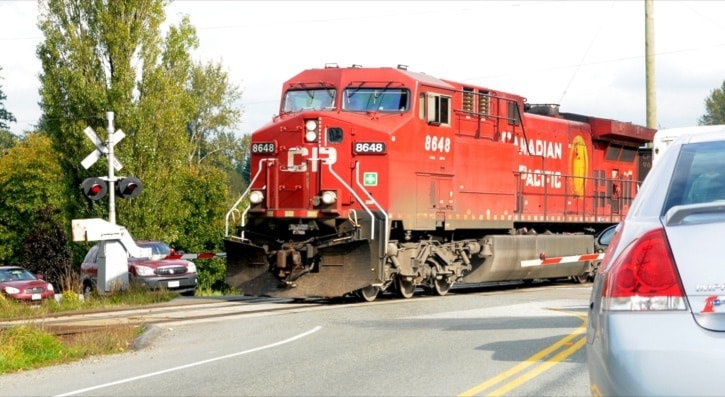The story behind the six-day period of flashing traffic lights at Production Way and Fraser Highway is a complex one, and it is not over yet.
On April 27, the City of Langley announced that the traffic light. which has been in place for nine years, would be changing temporarily to a flashing green on Fraser Highway, and a flashing red, pedestrian-activated light for Production Way traffic.
The City stated that changes were being made to the signals to allow them to move traffic better when a train was passing at the nearby rail crossing. This work was being done in conjunction with Canadian Pacific Railway, and the lights would remain flashing until October.
What the press release didn’t say was that the City, CPR and Transport Canada have been working on this issue for some time. The federal agency requires that traffic signals within a certain distance of a rail crossing must be set up so that they can move traffic on cross streets and avoid some of the congestion that comes when a train passes.
The City was not aware of this rule when the light went in nine years ago.
The City and CPR were working on changes to the signal, which will require about a $300,000 expenditure on the part of the railway and another $30,000 from the City. The two parties had applied for a federal grant to cover most of that cost, but word on it has been held up due to a departmental reorganization within the agency.
Thus the City was surprised to receive a “notice of insufficient action” from Transport Canada in February, and even more surprised at an order issued on April 7, the day before Easter Sunday, which stated that all trains using the crossing would have to slow down to 10 miles per hour, from the posted 30 mph speed limit.
City engineer Gary Vlieg said this meant that long trains would take 12 minutes to cross the road, and with about 16 trains per day, the levels of traffic congestion would be very high. The City was also concerned that this would mean emergency crews would not be able to respond to calls on the other side of the tracks at various times of the day.
“The City said this was not acceptable,” he said, in its response to the agency.
But Transport Canada was unmoved, and the City had to agree to change to the flashing lights until the signal work was complete, in order to keep trains moving at 30 mph.
After the signals were changed on Thursday, April 27, there were at least four crashes at the intersection. The City asked MP Mark Warawa to intercede, and he was able to get Transport Canada to agree to allow the light to go back to normal operation, pending a meeting between the agency, the City and the railway. The light went back to normal operation last Wednesday night.
Meanwhile, the signal work is continuing and Vlieg said the plan is to have it done by October. The City and railway have their grant applications in, but have not heard yet. The City has been told this is the number one priority in Transport Canada’s list of railway crossing improvements in the Lower Mainland.
The changes to the signal have nothing to do with the ongoing Roberts Bank Rail Corridor program and do not receive funding from that program.
The meeting to discuss the traffic signal has not yet been set up, but Vlieg was hopeful on Wednesday that it will be arranged soon.
Transport Canada spokesman Sara Johnston gave the agency's response to the controversy on Friday.
“As a result of an April 2012 railway inspection, Transport Canada issued a notice and order under the Railway Safety Act to inform them (City and railway) of an immediate threat to safe railway operations,” she said.
